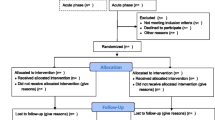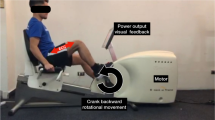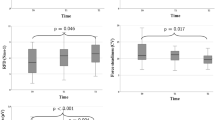Abstract
The purpose of this study was to investigate whether individual leg cycling could produce higher whole body peak oxygen uptake (VO2peak) than two legs cycling during aerobic high intensity interval training in chronic obstructive pulmonary disease (COPD) patients. Nineteen patients trained in 24 supervised cycling sessions either by one leg training (OLT) (n = 12) or by two legs training (TLT) (n = 7) at 4 × 4 min intervals at 85–95% of peak heart rate. Whole body VO2peak and peak work rate increased significantly by 12 and 23% in the OLT, and by 6 and 12% in the TLT from pre- to post-training, respectively, and were significantly greater in the OLT than the TLT (P < 0.05). The present study demonstrates that one leg aerobic high intensity interval cycling is superior to two legs in increasing whole body VO2peak, indicating a muscle rather than a cardiovascular limitation to VO2peak in these COPD patients.

Similar content being viewed by others
References
Ambrosino N, Strambi S (2004) New strategies to improve exercise tolerance in chronic obstructive pulmonary disease. Eur Respir J 24:313–322. doi:10.1183/09031936.04.00002904
American Thoracic Society, European Respiratory Society (1999) Skeletal muscle dysfunction in chronic obstructive pulmonary disease. A statement of the American Thoracic Society and European Respiratory Society. Am J Respir Crit Care Med 159:S1–S40
Casaburi R, Patessio A, Ioli F et al (1991) Reductions in exercise lactic acidosis and ventilation as a result of exercise training in patients with obstructive lung disease. Am Rev Respir Dis 143:9–18
Cotes JE, Chinn DJ, Miller MR (2006) Lung function. Blackwell Publishing, Oxford, p 131
Dolmage TE, Goldstein RS (2006) Response to one-legged cycling in patients with COPD. Chest 129:325–332. doi:10.1378/chest.129.2.325
Dolmage TE, Goldstein RS (2008) Effects of one-legged exercise training of patients with COPD. Chest 133:370–376. doi:10.1378/chest.07-1423
Gosker HR, Wouters EF, van der Vusse GJ et al (2000) Skeletal muscle dysfunction in chronic obstructive pulmonary disease and chronic heart failure: underlying mechanisms and therapy perspectives. Am J Clin Nutr 71:1033–1047
Helgerud J, Hoydal K, Wang E et al (2007) Aerobic high-intensity intervals improve VO2max more than moderate training. Med Sci Sports Exerc 39:665–671. doi:10.1249/mss.0b013e3180304570
Hsieh MJ, Lan CC, Chen NH et al (2007) Effects of high-intensity exercise training in a pulmonary rehabilitation programme for patients with chronic obstructive pulmonary disease. Respirology 12:381–388. doi:10.1111/j.1440-1843.2007.01077.x
Jobin J, Maltais F, Doyon JF et al (1998) Chronic obstructive pulmonary disease: capillarity and fiber-type characteristics of skeletal muscle. J Cardiopulm Rehabil 18:432–437. doi:10.1097/00008483-199811000-00005
Jones NL, Killian KJ (1990) Exercise in chronic airway obstruction. In: Bouchard C, Shepard RJ, McPearson BD (eds) Exercise, fitness and health. Human Kinetics, Champaign, pp 547–559
Klausen K, Secher NH, Clausen JP et al (1982) Central and regional circulatory adaptations to one-leg training. J Appl Physiol 52:976–983
Maltais F, LeBlanc P, Jobin J et al (1997) Intensity of training and physiologic adaptation in patients with chronic obstructive pulmonary disease. Am J Respir Crit Care Med 155:555–561
Maltais F, LeBlanc P, Whittom F et al (2000) Oxidative enzyme activities of the vastus lateralis muscle and the functional status in patients with COPD. Thorax 55:848–853. doi:10.1136/thorax.55.10.848
Martinez JA, Straccia L, Sobrani E et al (2000) Dyspnea scales in the assessment of illiterate patients with chronic obstructive pulmonary disease. Am J Med Sci 320:240–243. doi:10.1097/00000441-200010000-00003
Richardson RS, Saltin B (1998) Human muscle blood flow and metabolism studied in the isolated quadriceps muscles. Med Sci Sports Exerc 30:28–33. doi:10.1097/00005768-199801000-00005
Richardson RS, Grassi B, Gavin TP et al (1999a) Evidence of O2 supply-dependent VO2max in the exercise-trained human quadriceps. J Appl Physiol 86:1048–1053
Richardson RS, Sheldon J, Poole DC et al (1999b) Evidence of skeletal muscle metabolic reserve during whole body exercise in patients with chronic obstructive pulmonary disease. Am J Respir Crit Care Med 159:881–885
Richardson RS, Harms CA, Grassi B et al (2000) Skeletal muscle: master or slave of the cardiovascular system? Med Sci Sports Exerc 32:89–93. doi:10.1097/00005768-200001000-00014
Rognmo O, Hetland E, Helgerud J et al (2004) High intensity aerobic interval exercise is superior to moderate intensity exercise for increasing aerobic capacity in patients with coronary artery disease. Eur J Cardiovasc Prev Rehabil 11:216–222. doi:10.1097/01.hjr.0000131677.96762.0c
Slordahl SA, Wang E, Hoff J et al (2005) Effective training for patients with intermittent claudication. Scand Cardiovasc J 39:244–249. doi:10.1080/14017430510035844
Vogiatzis I, Nanas S, Roussos C (2002) Interval training as an alternative modality to continuous exercise in patients with COPD. Eur Respir J 20:12–19. doi:10.1183/09031936.02.01152001
Wagner PD (2006) Skeletal muscles in chronic obstructive pulmonary disease: deconditioning, or myopathy? Respirology 11:681–686. doi:10.1111/j.1440-1843.2006.00939.x
Wetter TJ, Dempsey JA (2000) Pulmonary system and endurance exercise. In: Shepard RJ, Åstrand PO (eds) Endurance in sport. The encyclopaedia of sports medicine. Blackwell Sci Inc., Malden, pp 52–67
Whipp BJ, Casaburi R (1994) Physical activity, fitness and chronic lung disease. In: Bouchard C, Shepard RJ, Stephens T (eds) Physical activity, fitness and health. Human Kinetics, Champaign, pp 749–759
Wouters EF (2002) Chronic obstructive pulmonary disease. 5: systemic effects of COPD. Thorax 57:1067–1070. doi:10.1136/thorax.57.12.1067
Acknowledgments
We gratefully acknowledge research nurses Birgit Pedersen and Inger Lise Bjerkan at Department of Pulmonary Medicine, St Olavs University Hospital, Trondheim, Norway for the valuable assistance in patient recruitment and testing. The present experiment complies with the current ethical laws in Norway. The study was approved by the regional ethical committee and conducted in accordance with the Helsinki Declaration.
Conflict of interest statement
None declared.
Author information
Authors and Affiliations
Corresponding author
Rights and permissions
About this article
Cite this article
Bjørgen, S., Hoff, J., Husby, V.S. et al. Aerobic high intensity one and two legs interval cycling in chronic obstructive pulmonary disease: the sum of the parts is greater than the whole. Eur J Appl Physiol 106, 501–507 (2009). https://doi.org/10.1007/s00421-009-1038-1
Accepted:
Published:
Issue Date:
DOI: https://doi.org/10.1007/s00421-009-1038-1




